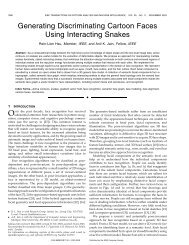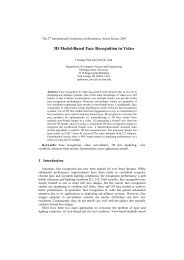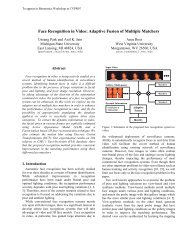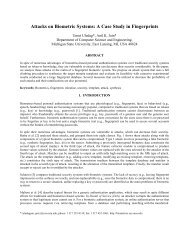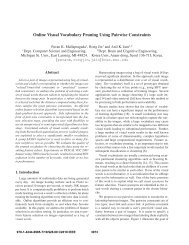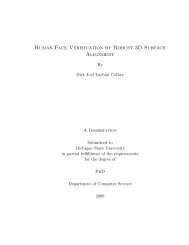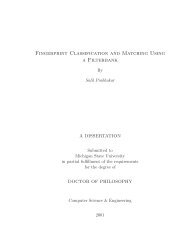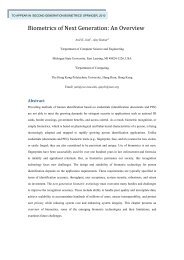Face Detection and Modeling for Recognition - Biometrics Research ...
Face Detection and Modeling for Recognition - Biometrics Research ...
Face Detection and Modeling for Recognition - Biometrics Research ...
Create successful ePaper yourself
Turn your PDF publications into a flip-book with our unique Google optimized e-Paper software.
<strong>and</strong> nose in frontal views), <strong>and</strong> because the extraction is time-consuming <strong>and</strong> usually<br />
generates triangles of the same size in the mesh. Hence, in our model construction, the<br />
desired recognition-oriented facial features can be specified <strong>and</strong> gradually modified<br />
in the 3D generic face model. The modeling algorithm generates an adapted/learned<br />
3D face model with aligned facial texture. The 2D projections of the texture-mapped<br />
3D model are further used <strong>for</strong> face verification <strong>and</strong> recognition.<br />
4.2 Generic <strong>Face</strong> Model<br />
We choose Waters’ animation model [69], which contains 256 vertices <strong>and</strong> 441 facets<br />
<strong>for</strong> one half of the face, because this model captures most of the facial features that are<br />
needed <strong>for</strong> face recognition (as well as animation), <strong>and</strong> because triangular meshes are<br />
suitable <strong>for</strong> free-<strong>for</strong>m surfaces like faces [136]. Figure 4.2 shows the frontal <strong>and</strong> one side<br />
view of the model, <strong>and</strong> facial features such as eyes, nose, mouth, face boundary, <strong>and</strong><br />
chin. There are openings at both the eyes <strong>and</strong> the mouth, which can be manipulated.<br />
The Phong-shaded appearance of this model is shown <strong>for</strong> three different views in<br />
Fig. 4.3.<br />
99



